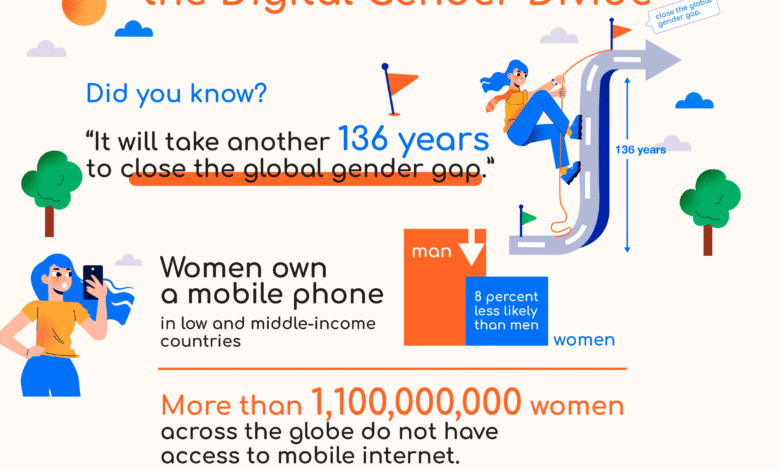Digital Gender Divide: Closing the Gap for Women in Tech

The digital gender divide remains a pressing issue, affecting millions of women and girls around the globe. As society increasingly relies on technology for education, employment, and empowerment, this disparity underscores a critical barrier that must be addressed. Currently, in 2024, 189 million fewer women than men have access to the internet, perpetuating the ICT gender gap. Ensuring technology access for women is crucial not only for individual growth but also for realizing the full potential of our digital economy. To foster inclusive digital transformation, we must invest in digital education for girls, equipping them with the skills needed to thrive in the evolving tech landscape.
The disparity in digital access between genders, often referred to as the technological gender gap, presents a significant challenge in the modern world. As digital transformation sweeps across industries and societies, many women and girls find themselves on the periphery of this evolution, lacking opportunities to engage fully in the digital realm. This gap goes beyond mere connectivity; it encompasses the need for comprehensive support systems that promote women’s active participation in technology. With an emphasis on fostering women’s roles in tech, it becomes essential to advocate for inclusive initiatives that enhance access to technology and education for young girls. Closing this gap not only empowers women but also enriches our collective digital future.
The Importance of Bridging the Digital Gender Divide
The digital gender divide encompasses the significant gap between men and women in terms of access to digital technologies and the internet. With millions of women still lacking essential access to technology, discussions around closing this divide have never been more critical. According to recent statistics, in 2024, there were approximately 189 million fewer women than men connected online. This disparity is compounded by systemic barriers that hinder women’s engagement in the digital space, making it imperative to foster conditions that encourage inclusive digital transformation.
Bridging the digital gender gap is not just about improving online connectivity but also about enhancing digital literacy and skills among women. For this transformation to be effective, women must have access to reliable devices and the training necessary to utilize them fully. This involves a commitment to investing in programs that support digital education for girls, ensuring they are equipped with the skills required to thrive in a technology-driven world. Programs and initiatives like Girls in ICT Day play a vital role in inspiring and empowering young women to pursue careers in STEM, ultimately helping to shape a more equitable digital future.
Empowering Women through Digital Education
Digital education serves as a critical platform for empowering women and closing the ICT gender gap. Providing women and girls with the tools and skills they need to navigate the digital landscape can open doors to career opportunities, enhanced educational outcomes, and greater participation in the economy. Investment in targeted digital education programs is essential, particularly those designed specifically for girls, to ensure they feel confident in their capacity to engage with technology.
Moreover, inclusive digital education initiatives help foster a culture of innovation and creativity among women. By enabling greater access to training in digital technology, women are encouraged not only to become consumers of technology but also creators. This paradigm shift is crucial for promoting equity in the tech space, as women can apply their unique perspectives and experiences to drive innovation. Encouraging more women to enter the tech sector will help reshape the industry, contributing to a healthier and more diversified digital economy.
Inclusive Digital Transformation: A Collective Responsibility
The concept of inclusive digital transformation goes beyond merely increasing internet access; it requires a concerted effort from all stakeholders to create environments where women can thrive in technology. Governments, businesses, and educational institutions must work together to dismantle the barriers that perpetuate the digital gender divide. This includes creating policies that promote equal opportunities for women in tech and fostering safe online spaces for women and girls.
As highlighted by Ms. Bogdan-Martin, a collaborative approach involving entrepreneurs, educators, and policymakers is necessary to ensure that women can connect, create, and lead in digital environments. By engaging various sectors and communities, we can develop comprehensive strategies that cater to the needs of women seeking to make their mark in the digital landscape. This collective responsibility not only benefits women but also enriches the digital community as a whole, making space for diverse voices and solutions.
The Role of STEM in Empowering Girls
STEM education plays a pivotal role in empowering girls and equipping them with the skills necessary for success in the digital age. The encouraged participation of girls in science, technology, engineering, and mathematics has gained significant traction through dedicated initiatives like International Girls in ICT Day. By fostering an environment where girls can explore and develop their interests in these fields, we can help cultivate a workforce that is both skilled and diverse.
Furthermore, engaging girls in STEM activities encourages problem-solving, critical thinking, and creativity. These essential skills are not only valuable in technical careers but are also applicable across various sectors, further bridging the gender gap in technology. By investing in organizations and programs that focus on STEM education for girls, we are laying down the groundwork for a more balanced and equitable future where both women and men can lead in digital transformation.
Addressing Systemic Barriers to Technology Access
Addressing the systemic barriers that prevent women from accessing technology and digital resources is crucial to ending the digital gender divide. Issues such as economic inequality, lack of transportation, cultural norms, and inadequate education systems create significant obstacles for many women seeking to enter the digital space. Recognizing these barriers allows for more focused interventions that can effectively support women in overcoming challenges.
To create lasting change, initiatives need to be multifaceted, combining efforts in education, community outreach, and policy reform. For instance, local governments can collaborate with tech companies to offer subsidized internet services and access to devices for women in underserved areas. Additionally, providing mentorship programs that connect aspiring female technologists with established professionals can inspire a new generation of women to pursue careers in technology and innovation.
The Transformative Power of Connectivity for Women
Connectivity is not merely about linking individuals to the internet; it is about creating opportunities that can transform lives and communities. For women, access to digital tools means increased chances for education, employment, and empowerment. In the digital age, having connection enables women to participate in global dialogues, expand their networks, and access resources that were previously out of reach.
Harnessing the transformative power of connectivity involves more than just physical access to technology; it requires the development of skills and confidence to utilize technology effectively. By fostering environments where women feel supported and encouraged to explore digital platforms, we can cultivate a generation of female leaders ready to shape the future. Whether through online learning platforms, virtual communities, or entrepreneurship, the potential of connected women is boundless.
Creating Safe Online Spaces for Women and Girls
Creating safe online spaces is paramount for ensuring that women and girls can fully engage in the digital world. The fear of harassment, discrimination, or abuse can deter many women from participating in online communities or pursuing careers in technology. Thus, it is important to develop policies and practices that guarantee the safety and respect of all participants in digital environments.
Organizations, platforms, and educational institutions can take proactive measures to create supportive online communities. This includes implementing strict anti-harassment policies, providing security features that protect user anonymity, and offering resources for reporting and addressing abuse. By fostering inclusive environments, we empower women to share their voices and experiences freely, paving the way for greater gender equality in the digital realm.
The Global Impact of Girls in ICT Day
Girls in ICT Day serves as a significant reminder of the global effort to promote gender equality in the technology sector. Since its inception in 2011, the initiative has fostered awareness and facilitated the participation of girls in technology through various events and activities worldwide. With the engagement of over 417,000 girls in 175 countries, the day has become a symbolic celebration of girls’ potential in tech and the importance of inclusive digital transformation.
The ongoing success of Girls in ICT Day highlights the need for continued investment in digital education for girls and the promotion of female role models in STEM. By showcasing the success stories of women in tech and the opportunities available to young girls, we can inspire future generations to envision themselves as leaders and innovators in the digital space. This continued focus on encouraging girls in ICT will play a pivotal role in shaping a more equitable tech industry.
Investing in Women’s Digital Future
Investing in women’s digital futures is essential for building a more resilient and inclusive global economy. By directing funding and resources towards women-centered tech initiatives, we can help dismantle the barriers that have historically marginalized women in this space. Prioritizing investment in programs that focus on digital education, technology access, and mentorship for women fosters an environment where they can thrive.
Additionally, when women succeed in technology, the benefits extend beyond individuals and families to communities and economies. Women bring unique perspectives and innovative solutions to the table, and their contributions can lead to more sustainable growth. Thus, embracing investment in women’s digital futures is not just a matter of equity; it is a strategic necessity for creating a vibrant and competitive economy that leverages the talents of all its members.
Frequently Asked Questions
What is the digital gender divide and why is it important?
The digital gender divide refers to the disparity in access to digital technology and the internet between men and women. This gap impacts opportunities for women in tech, education, and the workforce. Addressing the digital gender divide is crucial as it ensures that women can participate fully in the digital economy, thereby fostering inclusive digital transformation and economic growth.
How does the digital gender divide affect women’s access to education?
The digital gender divide significantly hampers women’s access to educational resources, particularly digital education for girls. With millions of women lacking internet access, they are denied opportunities to learn digital skills, pursue STEM careers, and enhance their educational prospects, further perpetuating gender inequality in society.
What role does the ICT gender gap play in the global economy?
The ICT gender gap highlights the underrepresentation of women in information and communication technology fields. This gap restricts women’s opportunities to contribute to the global economy, especially in tech-driven sectors. Closing the ICT gender gap is essential for fostering equal opportunities, enhancing innovation, and driving economic growth.
How can we promote inclusive digital transformation for women?
Promoting inclusive digital transformation for women involves investing in digital education for girls, ensuring equal access to technology, and creating supportive environments for women in tech. This includes offering training programs, mentorship, and resources to empower women, enabling them to not only access but thrive in the digital space.
What initiatives support women in tech to bridge the digital gender divide?
Various initiatives aim to support women in tech, including Girls in ICT Day, which encourages girls to pursue careers in STEM. These initiatives promote awareness and investment in women’s digital education, enhance technology access for women, and foster networks that empower them to lead and innovate in technology fields.
Why is technology access for women critical in closing the digital gender divide?
Technology access for women is critical because it empowers them to connect, create, and participate in the digital economy. Without adequate access to digital devices and services, women miss educational and economic opportunities, which reinforces the digital gender divide. Ensuring technology access is a foundational step toward gender equality.
How do systemic barriers contribute to the digital gender divide?
Systemic barriers, such as cultural norms, lack of funding for women’s tech education, and inadequate infrastructure, contribute significantly to the digital gender divide. These barriers limit women’s ability to access technology and develop necessary skills, thereby slowing the progress toward gender equality in the digital realm.
What can individuals do to help reduce the digital gender divide?
Individuals can help reduce the digital gender divide by advocating for equal access to technology, supporting initiatives focused on digital education for girls, mentoring women in tech, and promoting policies that address systemic barriers to technology access. By taking these actions, we can contribute to a more inclusive and equitable digital future.
| Key Point | Details |
|---|---|
| Digital Gender Divide | Millions of women and girls are excluded from digital technologies and opportunities. |
| Statistics | In 2024, there were 189 million fewer women online than men. |
| Systemic Barriers | Access to technology reflects deeper systemic issues rather than a simple digital divide. |
| Importance of Connectivity | Connectivity alone is not enough. Women need to afford devices and have the skills to use them. |
| Girls in ICT Day | Celebrated annually, encouraging girls to pursue STEM careers. |
| Call to Action | More investment is needed in girls’ digital education and technology access. |
| Creating Not Just Consuming | Encouragement for young women to become creators in the digital world. |
Summary
The digital gender divide is a critical issue that affects millions of women and girls around the world, denying them essential access to opportunities in an increasingly digital economy. As highlighted during International Girls in ICT Day, bridging this divide is vital not only for individual empowerment but also for societal progress. Meaningful engagement in digital spaces requires not just access but also the skills and safety necessary for women to thrive. With significant statistics reflecting the disparity in online access between men and women, there is a clear call for investment in digital education and resources, ensuring that women do not just consume technology, but also create and lead in the digital landscape.




